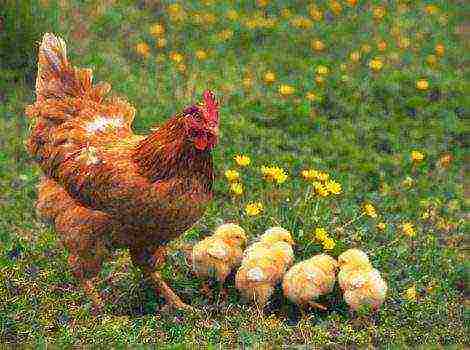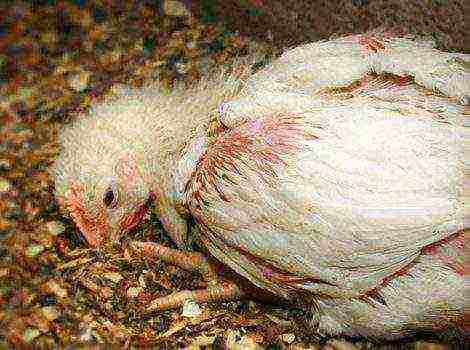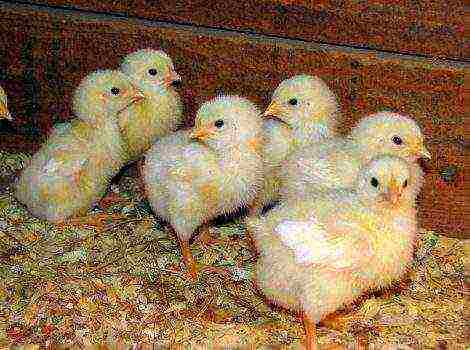Content
- 1 Chicken manure as fertilizer
Chicken manure as fertilizer
To grow a good harvest of agricultural crops, it is necessary to constantly replenish the soil with reserves of nutrients, which it gives along with the harvest. Otherwise, the top fertile layer will be depleted. To take something, you must first give something. In this case, endlessly harvesting without saturating the soil with substances is a thoughtless and mismanaged attitude towards our land-breadwinner.
Both mineral and organic fertilizers can be applied to the soil. It is better to do it in a complex manner. However, mineral fertilizers are expensive. As a way out, you can use organics prepared in a certain way. Organic nutrients are animal excrement - manure and for example chicken droppings. If you keep chickens, geese, ducks, turkeys in your backyard or in the country, you will not find a better fertilizer than droppings from this poultry for plant nutrition.
Chicken droppings composition
The main constituent elements of chicken manure are:
- nitrogen compounds;
- phosphorus;
- potassium;
- calcium;
- various macro- and microelements;
- lime;
- phosphoric acid;
- magnesium;
- sulfur;
- potassium oxide;
- biologically active compounds;
- other elements.
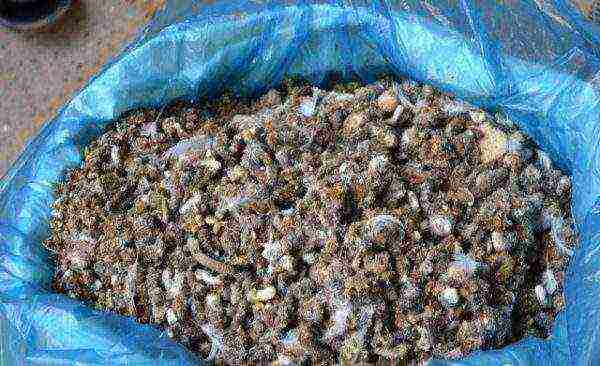
Poultry manure contains several times more phosphorus than cow dung, in its composition has nitrogen up to 2%, which is three to four times more than in the above organic fertilizer. Ammonia compounds in it are so concentrated that it is impossible to introduce this organic matter into the soil in its pure form directly for plant nutrition.
How to collect and store
Due to the fact that chicken manure contains a large amount of gases (methane, ammonia), there are special methods for its preparation, storage and introduction into the soil.
Typically, chicken manure is collected from the coop along with a small amount of bedding (straw). If the chickens are kept outdoors in an open-air enclosure, then you can rake it together with a small layer of earth. We do not perform any special cleaning. The most common storage methods are:
- In a heap in bulk;
- Compost heaps or pits;
- Dry granules or powder.
The first storage method is the simplest, common, but it has the least effect. With this method, when cleaning the chicken coop, chicken droppings are simply raked into a heap and stacked in the corner of the garden or garden plot. At best, cover with a film until it is introduced into the soil. Main disadvantage: droppings dry quickly, forming lumps and layers. In addition, during the drying process, it loses most of its nitrogen in the form of ammonia.
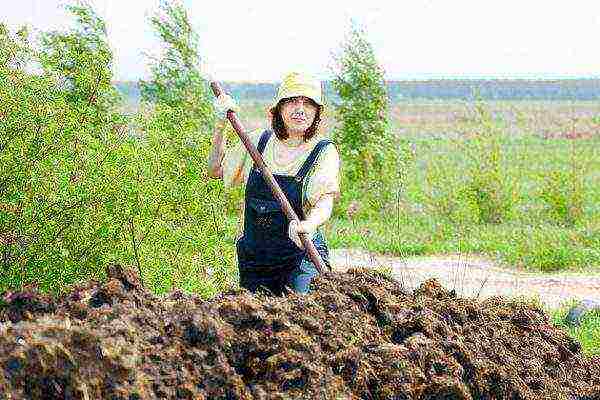
The most acceptable and reasonable way to store droppings at home is preparing compost piles or pits... This is done in the following way: a small layer of droppings (10-15 cm) is spread on a straw bedding 15-20 cm thick. Next, we alternate layers from what is at hand. This can be peat, soil, cow dung, straw again, etc. All this is formed in the form of a heap or folded into a pit, hermetically covered with a film on top to enhance anaerobic processes and increase the temperature inside the heap or pit. After three or four months, you can check the contents. If the compost is ready, it is added in certain proportions, which will be discussed below. To speed up the fermentation and processing processes you can use EM-preparations that contain bacteria in a concentrated form.
The third way to store droppings (dry granules or powder) is mainly used in factory conditions. Dried at a temperature of about 600 ° C, the droppings are freed from pathogens and weed seeds. In addition, the dry mix does not have a specific odor. You can buy fertilizer made in this way in stores. Convenient packaging - from several hundred grams to several tens of kilograms.
What plants are suitable for
Chicken manure as fertilizer is suitable for almost all crops: cereals, vegetables, berries, fruit trees. The exception is onions, garlic, and other herbs during active growth. Of vegetables, cabbage, cucumbers, tomatoes, eggplants respond well to dropping. Berry and fruit trees have no exceptions in the positive effect of their use.
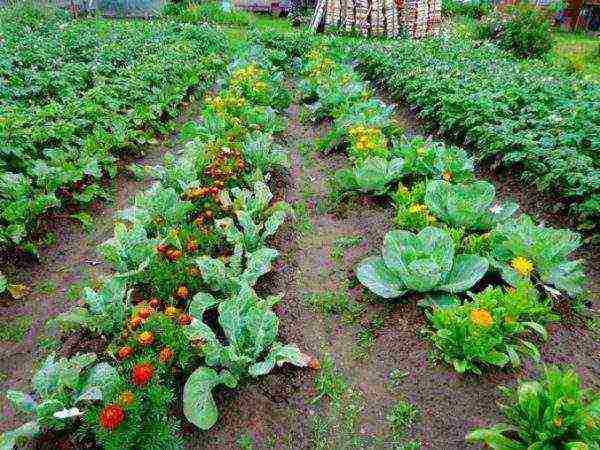
Fertilizer application rate table for different crops, t / ha
| Culture name | litter | |||
| dry | bedding | natural moisture | from compost heaps or pits | |
| cereals | 3-4 | 8-12 | 7-9 | 18-22 |
| potato | 3-4 | 9-13 | 8-10 | 20-24 |
| fodder root crops | 5-6 | 12-16 | 9-12 | 25-30 |
| vegetable crops | 6-8 | 20-25 | 12-17 | 30-40 |
| berry | 8-10 | 20-25 | 17-20 | 40-50 |
| fruit | 10-12 | 25-30 | 20-25 | 45-55 |
Application of chicken manure in granules, how to breed
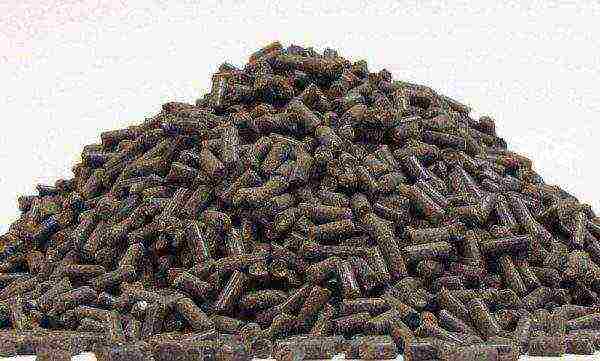
To apply dry droppings in granules, first it is diluted in any container with water (barrel, bucket). The proportion is maintained at 1:25, unless otherwise stated on the package when purchasing fertilizer. Be sure to insist for 50-70 hours. Fruit trees are fertilized in tree trunks. Vegetables are watered directly over the beds. It is advisable to rinse the leaves of the plants if the solution gets on them. The approximate application rates are shown in the table above. Watered with this solution 2 or 3 times per season.
How to use dry bird droppings as fertilizer
Dry manure can be applied in two ways:
- If it is very fine or powdery, it can be scatter on the soil in late autumn before winter in moderation (about one and a half - two times more than would be required for growing plants). In this form, dry droppings can also be applied to holes for vegetables, shrubs or trees. Consumption rate is indicated in the table.
- Fertilize with a solution. Just as with the use of granules, it is first diluted in any container with water. The proportion is kept 1:25, unless otherwise written on the package. Insist for two to three days.
How to apply litter manure from compost heaps
Before applying the fertilizer stored in the above way, you need it dilute in containers... The bucket is not suitable for this purpose. You need to pick up a vessel with a volume of 20 liters or more. Litter droppings should take longer to ferment. This will take more time. Compost litter is almost ready to use. It is enough to insist on water for several hours.
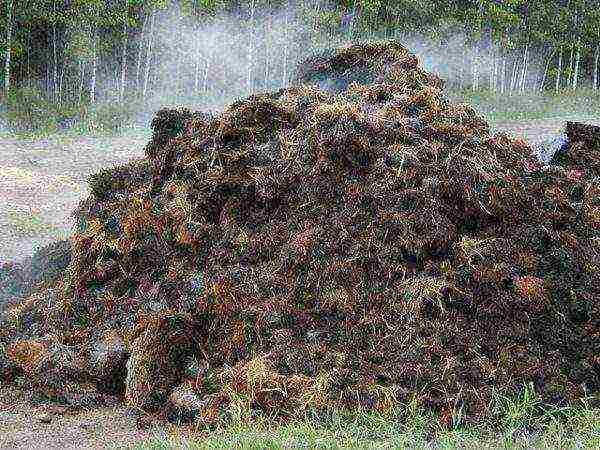
You can also apply the technique of scattering it over the site... This is done in the fall after harvesting all crops. In the spring, with melt water, the bulk of the nutrients will enter the soil. The remaining solid mass will serve as an excellent means for structuring the soil itself.
Advantages and disadvantages
The use of chicken manure in the cultivation of crops has positive action:
- On the structure and properties of the soil: is an excellent leavening agent. In addition, it saturates the fertile layer with nutrients for microflora and plants.Due to the introduction of droppings into the soil, aerobic and anaerobic processes are enhanced;
- On the plants themselves: they take additional nutrients in an assimilable form for themselves to build up green, tuberous or fruit mass (depending on the culture);
- At the time of fruit ripening: we get an earlier harvest;
- In terms of duration of use it as a fertilizer applied to the soil for two to three years;
- On the restoration of the pH of the medium soil;
- On the rise plant disease resistance.
In addition, chicken manure is cheaper than mineral fertilizers. Therefore, partly, it can replace them.
However, this substance has one drawback... Since the droppings contain many elements in a concentrated amount, its excess in the soil negatively affects the growth and development of plants, up to their death. Therefore, very it is important not to overfeed vegetables, berries and other crops.
Nature itself gives us the means and methods for its maintenance. It is not necessary to use "chemistry", to invent genetically mutated organisms for our life and development. It is important to use the existing wealth rationally, not forgetting about their replenishment through reproduction.
